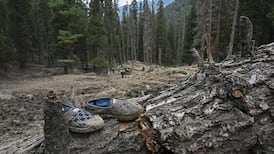In the pantheon of Fukushima heroes, Masao Yoshida stands taller than almost everyone else.
As manager of the crippled Daiichi plant in 2011, he was the captain of a nuclear Titanic, ready to go down with his ship rather than let it spin completely out of control.
He later gave the most complete account from the cockpit of the world’s worst nuclear disaster since Chernobyl. The account, recorded in 13 interviews from July to November 2011 as part of the lengthy government inquiry into the Fukushima crisis, was kept secret – until now.
After months of pressure, criticism and leaks, the government was finally forced to release the transcript last week. Inevitably, it is now at the centre of a toxic row over the legacy of nuclear power.
The Yoshida tapes were partially leaked this year, first by the Asahi, Japan's liberal flagship newspaper, then by the conservative Sankei, the Asahi's bitter rival. Each had strikingly different interpretations of its contents.
The Asahi, which is critical of attempts to restart the nation's 50 idling reactors, found evidence of terrifying bungling and worse by Tokyo Electric Power Co (Tepco), the operator of the plant.
In May it released extracts apparently showing that 650 of the 720 workers at the plant disobeyed Yoshida's orders and fled during the height of the crisis, when radiation spiked after a series of explosions. Tepco failed to mention these orders in its official accounts of what occurred, said the paper.
Confusion
But the
Sankei
mined the same extract and found confusion, not insubordination. Yoshida’s orders were not properly conveyed, and in any case he later agreed with the workers’ decision to evacuate to the Daini plant about 10km away, it said.
The newspaper accused the Asahi of "twisting" Yoshida's account to further the anti nuclear cause.
Last week, the Asahi was forced to admit that it had got the episode wrong and retracted the article. The admission, coming on the back of a separate mea culpa last month over the paper's coverage of Japanese war crimes, has deeply damaged its reputation.
The furore threatens to obscure, however, the profound crisis Japan faced in March 2011. Yoshida told investigators he feared the plant's entire payload of toxic nuclear fuel could have escaped. "Our image was that of a catastrophe for all of eastern Japan."
Three of the Daiichi’s six reactors melted down completely during the crisis, contaminating hundreds of square kilometres of countryside and forcing more than 300,000 people to flee. Many have not been able to return home.
Safety risks
Yoshida also warns of the safety risks of large nuclear plants, which he says are “difficult” to operate. He singles out Kashiwazaki Kariwa on Japan’s northern coast, the world’s largest plant. “I’ve always disliked the dense location [of nuclear reactors],” he says.
Arguments over what took place have simmered for over three years and both sides have well dug-in positions: one seeking to highlight the managerial and political faultlines of the nuclear industry, the other trying to shift blame elsewhere, particularly toward Naoto Kan, who was prime minister in 2011.
Now a leading anti-nuclear campaigner, Kan is credited by many with facing down Tepco to stop it abandoning the plant’s six reactors and seven lethal nuclear fuel pools. He later said he feared much of Japan’s densely populated eastern seaboard, including Tokyo, could have been left uninhabitable. Tepco denies any plan to abandon the Daiichi plant.
These arguments sharpened this week with the decision by Japan's nuclear regulator to signal the restart of the industry. To shouts of "shame" and "mad," nuclear regulation authority head Shunichi Tanaka told a public meeting the Sendai plant in the southwest met safety requirements needed to restart.
The Sendai decision is but a dry run for the reopening of the huge Kashiwazaki-Kariwa complex. Operator Tepco, which also owns the ruined Fukushima plant, says it is losing millions of dollars a month in revenue keeping the seven-reactor plant offline.
Kan said last week he was “confident” that the Yoshida transcript would support his version of events.
All sides at least agree on one point: Yoshida, a heavy smoker who died of oesophageal cancer last year, was made of tough stuff. After his death, Kan tweeted: “I bow in respect for his leadership and decision-making.”











